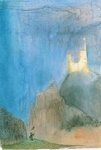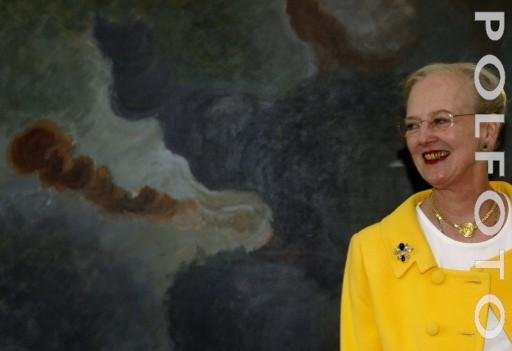She designed the costumes and apparently wrote the story too. She did this last week. [/b][/quote]
Here is an article from the American-Scandinavian Foundation from a couple of years back about the Queen including her artistic endeavors:
"Queen Margrethe II: Denmark's Monarch for a Modern Age
by Peter Thygesen
Margrethe II -"'Daisy" to family and friends- has an impressive way about her. The 59- year- old Queen has a highly sophisticated sense of humor and an affection for baroque situations. Long ago she developed a natural confidence, which did not originally seem to be part of her personality. Widely traveled, the Queen of Denmark delights in the huge royal celebrations which lend luster to Denmark, and during the preparations she gladly takes part in the tiniest details. She is also a great lover of splendor and strong colors, of precious gems and sumptuous gowns; she revels in a good dance, a challenging game of bridge, delicious food and interesting people. In recent years the Queen has entertained such figures as Pope John Paul II; US President Bill Clinton; Nelson Mandela, President of South Africa; and Cuba's President Fidel Castro.
The People's Love
It was a deeply grieved young woman who stepped out on the balcony of Christiansborg Palace in the center of Copenhagen on the bitterly cold day of January 14, 1972. Only the night before her beloved father had passed away after several few weeks of illness. Now Margrethe II stood in the chill wind with the immense responsibility of being the new Head of State, with all the obligations and expectations that the Danish population might have of her. For the first time, she met the Danes as their Queen and presented her motto: "God's help, the people's love, Denmark's strength."
The Danish population knew it had the best prepared monarch imaginable, well trained in the history of Denmark and well educated at excellent schools. After matriculating with distinction in 1959, Margrethe went on to study at universities in Copenhagen, Cambridge, Århus, Paris and London. There she studied political science and economics in addition to archaeology, the passionate interest of her youth.
This comprehensive education had been arranged by her parents, King Frederik IX and Queen Ingrid, in part because the Danish Constitution had been changed through a referendum in 1953 to allow female succession to the throne. With this change Margrethe's life had taken a new direction, so the royal couple's eldest daughter had to be slowly and naturally introduced to the duty she would one day take over.
A Ray of Sunshine
Princess Margrethe was born on April 16, 1940. As the first child of Denmark's Crown Prince Frederik and Crown Princess Ingrid, the infant princess's arrival was like a ray of sunshine in a time of darkness: Only a week earlier Hitler's troops had attacked and invaded the country. The new princess was named Margrethe Alexandrine Thorhildur Ingrid. During the five years of occupation the small family lived a relatively normal life at the royal palace in Copenhagen. In 1944 Crown Princess Ingrid gave birth to yet another daughter, Princess Benedikte, and in 1946 a third daughter arrived, Princess Anne-Marie. The grandfather of the three young princesses, King Christian X, died in 1947, and the scepter was passed to his son, Frederik IX.
In later years Queen Margrethe described the day before her 18th birthday as the worst moment of her life as heir to the throne. Suddenly the young woman recognized the implicit sadness of her situation: Only upon her father's death would her own existence really make sense. The Crown Princess was devastated, but used the years that followed to educate herself for one of the most unusual "jobs" that could ever be imagined.
The French Count
After completing her years of study, the Crown Princess went on two very long trips abroad—to South America and to Asia. Upon returning to Copenhagen, Margrethe told her parents that she had fallen in love with a young diplomat at the French embassy in London. In 1966 Margrethe's engagement to Count Henri de Laborde de Monpezat was announced, and the following year the couple was married in a spectacular ceremony in Copenhagen's splendid Holmens Kirke.
In May 1968 Crown Princess Margrethe gave birth to her first child, Prince Frederik, who is today the Crown Prince of Denmark. A second son, Prince Joachim, arrived a year later. (He has recently made the Queen a grandmother for the first time.)
An Old Monarchy
The young royal family had been together at Amalienborg Palace for only four years, when King Frederik IX died, and it was Margrethe's turn to assume high office as Head of State. She was 31 years old.
The Queen is the 49th Danish monarch in a direct line of succession from King Harald Bluetooth, who united Denmark more than a thousand years ago. She is the second woman to sit on the throne of Denmark, but in reality she is the first to be proclaimed Queen. Her predecessor and namesake, Margrete I (1353-1412), was styled "High and Mighty Lady and Regent" and ruled the kingdom on behalf of her infant son.
The legitimacy of the dynasty lies in its historical dimension. Denmark is one of the oldest kingdoms in Europe and in the World, but the monarchy must perform a delicate balancing act in today's democratic era. The code words are tradition, continuity, stability. But the capacity to change is also important.
Today the Danish Head of State has no form of political influence. The monarch has national symbolic significance, but plays no active role in the government of the country. For this reason the person concerned must be possessed of a strong character and be able to sustain his/her own integrity and the dignity of the position. Queen Margrethe II showed quickly that she had strong views about her role. The monarchy was slowly modernized and streamlined without losing its distinction.
A Woman of Strong Opinions
Although the Queen's unique status places her above any political discussion, she does not shy away from controversial issues. Her personal views are often expressed in her annual New Year's speeches, which are transmitted from Amalienborg Palace in Copenhagen on December 31. For Danes it is almost an annual ritual to see or hear The Queen's Speech when it is broadcast via Danish Television and Radio.
In recent years the Queen has called upon the Danish people to show more tolerance toward new citizens from foreign and often remote countries. She has also talked about environmental problems; world peace; stress and tension; violence in society; Danish identity, responsibility, freedom, pessimism, nationalism; the strength of Danish cultural roots; human rights; self-righteousness; the lack-of self-confidence of many citizens; and the possibilities of a small country in the larger world.
The Queen's weekdays are packed with official duties: She holds weekly meetings with ministers of state as well as Royal Audiences, where citizens thank Her Majesty for a decoration or a new job. The Queen routinely receives ambassadors and heads of state, reads a substantial number of official papers, and travels abroad frequently. She also visits many Danish cities, enterprises, institutions and organizations throughout the year.
Queen of Arts
Queen Margrethe is a success as a monarch in part because she also finds time to engage in artistic endeavors. She herself regards these creative activities as a major asset in her overall "business." Her artistic talent is presumably inherited from her maternal side, the Swedish Bernadotte family, which can point to numerous Royal Swedish artists among its members over several generations. From her father, Queen Margrethe inherited her love of music. She has also danced ballet for many years, though only in private classes.
Queen Margrethe is a visually gifted person, who often conceptualizes life's ups and downs in pictures. As a young girl the princess was attracted to the art of drawing, but it was not until her encounter with the universe of the writer J. R. R. Tolkien that the Queen began to transform her visions into pictures. In 1977 Tolkien's Lord of the Rings was published in Danish with illustrations by Ingahild Grathmer, a pseudonym the Queen used for her first works.
Over the years she has designed bishops' copes for several cathedrals in Denmark and chasubles for Kronborg in Elsinore and Ammasalik in Greenland. In addition to doing watercolors and oil paintings, the Queen has designed Christmas seals and created trademarks. Some of Her Majesty's illustrated books and calendars have been sold for charitable purposes. She has also taken part in reconstructing and refurbishing one of the four palaces of the Amalienborg complex. Each Thursday afternoon the Queen is "off-duty" to devote herself to this creative "business," whose results she loves to present to others or give as gifts to close friends.
In 1988 the Queen began to exhibit her work under her own name. Her artistic creations have been shown in Koge, Ebeltoft, Holte, Copenhagen, Herning, Elsinore and Århus in Denmark, as well as in Stockholm (Sweden), Reykjavík (Iceland), Flensburg (Germany) and lately in Oslo (Norway). Everywhere the public has crowded in to see them.
Earlier Her Majesty created costumes for the filmed version of Hans Christian Andersen's fairy tale, "The Shepherdess and The Chimney Sweep," shown on Danish television. The Queen's next major artistic project was the scenography for the production of August Bournonville's 1854 ballet Et Folkesagn (A Folk Tale) performed at The Royal Theatre in Copenhagen in 1991. In both cases the Queen not only supplied production sketches but went to work at the theater daily, joining the professional teams as a key participant.
The Queen was also heavily involved in the revival of Et Folkesagn at the end of August 1999, when it started its latest run at the Royal Theatre. The task was to create over one hundred costumes in addition to stage decorations for this three-act production. At the Royal Theatre the Queen was praised for her sense of color, confident style, and ability to involve herself in this enormous mission. In an interview with this writer, Queen Margrethe stated:
It has really taken a very big chunk of my time, but it is wonderful to do. This is not a project that I should do often during my lifetime, even though I guess I would be a better artist the more I tried. But this is still not my main occupation.
The Queen also explained why, in recent years, she has spent so much more time at her artistic pursuits:
I get strength to do my ‘job’ as head of state by permitting myself to express myself through the arts. I think I can also demonstrate that this has made my life as Queen easier for me. Without being able to express myself in a creative way and use the fantasy I have always had, I would probably have felt that it was hard to 'reload the batteries.'
Although Queen Margrethe II is very much occupied by the artistic dimension of her life, she never leaves any doubt that she is first and foremost The Head of State in The Kingdom of Denmark."
Peter Thygesen is a cultural and royal reporter for Politiken, one of Copenhagen's leading daily newspapers.
 art0008.jpg26.3 KB · Views: 3,385
art0008.jpg26.3 KB · Views: 3,385 art0007.jpg23.1 KB · Views: 4,536
art0007.jpg23.1 KB · Views: 4,536 art0006.jpg30 KB · Views: 3,402
art0006.jpg30 KB · Views: 3,402 art0005.jpg37.5 KB · Views: 3,459
art0005.jpg37.5 KB · Views: 3,459 art0004.jpg27.7 KB · Views: 3,323
art0004.jpg27.7 KB · Views: 3,323 art0003.jpg23.9 KB · Views: 3,328
art0003.jpg23.9 KB · Views: 3,328 art0002.jpg40.8 KB · Views: 3,322
art0002.jpg40.8 KB · Views: 3,322 art0001.jpg24.4 KB · Views: 3,330
art0001.jpg24.4 KB · Views: 3,330 painting.jpg20.8 KB · Views: 3,996
painting.jpg20.8 KB · Views: 3,996 mountains.jpg16.9 KB · Views: 3,501
mountains.jpg16.9 KB · Views: 3,501










 .
. 






























 I enjoyed her paintings and agree that she is talented.
I enjoyed her paintings and agree that she is talented.